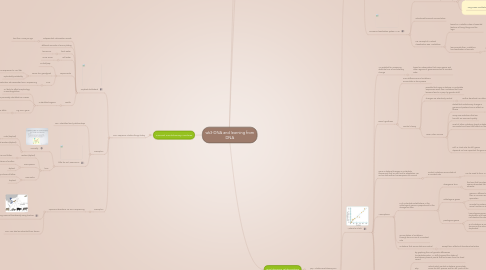
1. Current evolutionary contexs
1.1. DNA sequence clarifies things today
1.1.1. 3 spiked stickleback
1.1.1.1. independent colonization events
1.1.1.1.1. less than 10,00 yrs ago
1.1.1.2. different amounts of armor plating
1.1.1.3. fresh water
1.1.1.3.1. less armor
1.1.1.4. salt water
1.1.1.4.1. more armor
1.1.1.5. experiments
1.1.1.5.1. 20 fish/pop.
1.1.1.5.2. 45789 loci genotyped
1.1.1.5.3. RAD
1.1.1.6. results
1.1.1.6.1. 9 identified regions
1.1.2. example 2
1.1.2.1. DNA identifies family relationships
1.1.2.2. little fire ant Wasmannia
1.1.2.2.1. normally
1.1.2.2.2. here
1.1.3. example 3
1.1.3.1. Species interactions via DNA sequencing
1.1.3.1.1. Screening mammal biodiversity using leeches
1.1.3.1.2. DNA can also be extracted from faeces
2. Ok
3. DNA in evolution
3.1. species relationships are based on
3.1.1. bone sructures
3.1.2. morphologies
3.1.3. development
3.1.4. behaviour
3.1.5. ecological niche
3.1.6. DNA sequences
3.2. DNA sequences
3.2.1. mutations occur all the time
3.2.1.1. e.g. cancer
3.2.1.2. 50-100 mutations/year
3.2.2. Reasons for mutations
3.2.2.1. mistakes in DNA replication or recombination
3.2.2.2. mutagens(radiation,chemicals)
3.2.2.3. viruses
3.2.2.4. transposons
3.2.3. mutations only inherited in germ line
3.2.3.1. not inherited in somatic cells
3.2.4. Types of mutations
3.2.4.1. small
3.2.4.1.1. replacement,insertion,deletion
3.2.4.1.2. examples
3.2.4.2. Big
3.2.4.2.1. inversion
3.2.4.2.2. duplication
3.2.4.2.3. deletions
3.2.5. What happens to a mutation
3.2.5.1. most point mutations are neutral
3.2.5.1.1. eliminated by genetic dirft
3.2.5.1.2. hitchhiking
3.2.5.1.3. eliminated/fixated
3.2.5.2. some increase fitness and some are very deleterious
3.2.5.2.1. selection will eliminate/fixes them
3.2.5.3. Example
3.2.5.3.1. antennapedia (Hox gene) mutation
3.2.6. mutations = source of inheritable genetic variation
4. Evolutionary relationships
4.1. DNA clarifies evolutionary RLs between species
4.1.1. Molecular Data
4.1.1.1. mutations in DNA accumulate as speciation occurs and species diverge
4.1.1.2. can inspect differences in DNA sequences as indicators of phylogenetic difference between species
4.1.1.2.1. closely related species
4.1.1.2.2. distantly related species
4.1.1.2.3. example
4.1.1.3. use of protein sequences
4.1.1.3.1. DNA codes 4 proteins=chains of distinct amino acids
4.1.1.3.2. examine protein sequences between diff. species and use same criterion to plot relationships of species
4.1.1.3.3. criterion
4.1.1.4. Linnaeus classification system 1735
4.1.1.4.1. introduced standard hierarchy we use today
4.1.1.4.2. introduced binomial nomenclature
4.1.1.4.3. His concept of a natural classification was Aristotelian
4.1.2. Molecular Clock
4.1.2.1. =a yardstick for measuring absolute time of evolutionary change
4.1.2.1.1. based on observation that some genes and other regions of genomes evolve at constant rates
4.1.2.2. Basic hypothesis
4.1.2.2.1. more differences and mutations accumulate as time passes
4.1.2.2.2. Neutral Theory
4.1.2.3. gene mutations(changes in nucleotide sequences) that are not tied to adaptation can accumulate without consequence to survival
4.1.2.3.1. neutral mutations accumulate at a constant rate
4.1.2.4. Assumptions
4.1.2.4.1. # of nucleotide substitutions in the orthological genes is proportional to the divergence time
4.1.2.4.2. accumulation of mutations through time occurs at a constant rate
4.1.2.4.3. mutations that accumulate are neutral
4.1.2.5. Calibrating the molecular clock
4.1.2.5.1. by graphing the # of genetic differences (nucleotide,codon, AA diff.s) against the dates of evolutionary branch points that are known from the fossil record
4.1.2.5.2. why
4.1.2.5.3. by using a well dated fossil within a molecular phylogenetic tree
4.1.2.6. allows absolute and relative timing
4.1.2.7. Problems
4.1.2.7.1. some portions of the genome appear to have evolved in irregular burst
4.1.2.7.2. same gene may evolve at diff. rates in diff. gps of organisms
4.1.2.7.3. some genes evolve x 10^6 faster
4.1.2.7.4. rate of differentiation differs
4.1.2.7.5. only small amounts of data
4.1.2.7.6. differential segregation of alleles
4.1.2.7.7. do not sun as smoothly as predicted
4.1.3. sequence phylogenies
4.1.3.1. Carl Woese 1977
4.1.3.1.1. produced first phylogenetic tree of life using RNA ribosomal sequencing
4.1.3.1.2. 1st major split in life occurred when bacteria diverged from other organisms
4.1.3.1.3. eukaryotes and archaea are more closely to each other than either is to bacteria
4.1.3.1.4. branch length=
4.1.3.1.5. ribosomes are fundamental for cell
4.1.3.1.6. first phylogenetic tree of life
4.1.3.2. issues with sequence phylogenies
4.1.3.2.1. phylogenetic trees are based on assumption that genes are passed vertically from one gen. to another
4.1.3.2.2. can be ambiguous if not enough info
4.1.3.2.3. used to be expensive
4.1.3.2.4. Nuclear genes vs Mt genes
4.1.3.3. consensus with fossil record
4.1.3.3.1. molecular evolution analysis

